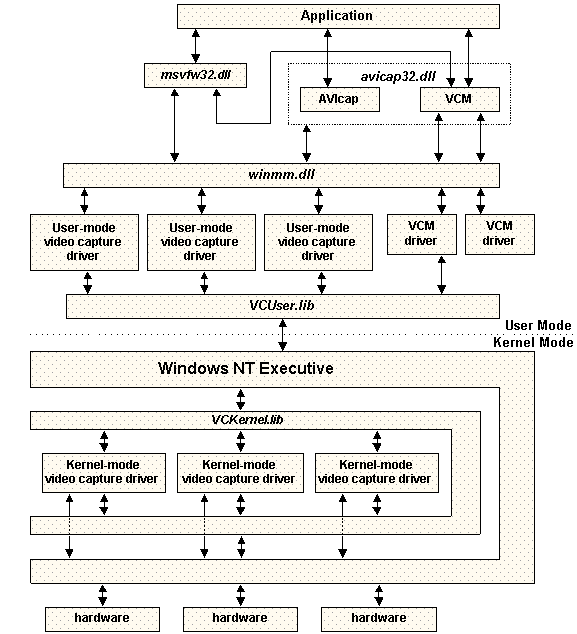Video Capture Software Components
The following diagram illustrates the relationship of the major Windows NT
video software components.

The components in the diagram include:
-
Application
-
Any user-mode, Win32-based application that creates an AVIcap window
(described in the Win32 SDK), calls the video API functions (described in the
Video for Windows Development Kit), or calls the Video Compression Manager
functions (also described in the Win32 SDK).
-
msvfw32.dll
-
Microsoft Video for Windows dynamic-link library. Exports the video API
functions described in the Video for Windows Development Kit. Also exports the
MCIWnd window class and DRAWDIB functions, described in the Win32 SDK.
Additionally, this library includes the Video Compression Manager. For more
information about the Video Compression Manager, see Video
Compression Manager Drivers.
-
avicap32.dll
-
Dynamic-link library supporting the AVI capture window class.
-
winmm.dll
-
Dynamic-link library that exports SendDriverMessage, which calls a
user-mode driverís DriverProc function. See winmm.dll.
-
User-mode video capture drivers
-
Dynamic-link libraries that communicate with kernel-mode drivers.
-
VCM drivers
-
Dynamic-link libraries that compress or decompress video data and either
return it to the caller or send it to a kernel-mode driver.
-
VCUser.lib
-
Library used as a basis for user-mode video capture drivers. For details, see Using
VCUser.lib.
-
VCKernel.lib
-
Library used as a basis for kernel-mode video capture drivers. For details,
see Using VCKernel.lib.
-
Kernel-mode video capture drivers
-
Kernel-mode code that communicates with the Windows NT Executive in order to
access device hardware.

